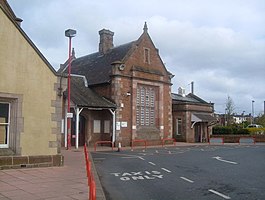Penrith railway station
| Penrith North Lakes |
|
|---|---|
 |
|
| Location | |
| Place | Penrith |
| Local authority | District of Eden |
| Coordinates | 54°39′43″N 2°45′29″W / 54.662°N 2.758°WCoordinates: 54°39′43″N 2°45′29″W / 54.662°N 2.758°W |
| Grid reference | NY511299 |
| Operations | |
| Station code | PNR |
| Managed by | Virgin Trains |
| Number of platforms | 3 |
| DfT category | D |
| Live arrivals/departures, station information and onward connections from National Rail Enquiries |
|
| Annual rail passenger usage* | |
| 2011/12 |
|
| 2012/13 |
|
| 2013/14 |
|
| 2014/15 |
|
| 2015/16 |
|
| Listed status | |
| Listed feature | Penrith Station |
| Listing grade | Grade II listed |
| Entry number | 1326905 |
| Added to list | 9 February 1983 |
| National Rail – UK railway stations | |
| * Annual estimated passenger usage based on sales of tickets in stated financial year(s) which end or originate at Penrith North Lakes from Office of Rail and Road statistics. Methodology may vary year on year. | |
|
|
|
Penrith North Lakes railway station (often shortened to Penrith) is located on the West Coast Main Line in the United Kingdom. It serves the town of Penrith, Cumbria, and is less than one mile from its centre. National Express coaches leave from the station's car park and there are bus links to Keswick, Workington, Appleby-in-Westmorland and Ullswater.
The station was built by the Lancaster and Carlisle Railway, it was opened on 17 December 1846, and was designed by Sir William Tite. Although the station is now relatively quiet at one time this was the terminus for the Cockermouth, Keswick and Penrith Railway and the North Eastern Railway's Eden Valley branch which joined with the Stainmore line at Kirkby Stephen providing connections to the East Coast Main Line at Darlington. There was also in the mid-nineteenth century a plan to connect Penrith by rail to the lead mines at Caldbeck and eventually joining up with the Cumbrian Coast Line near Wigton. Passenger services to Kirkby Stephen and Darlington were withdrawn in 1962, whilst those to Cockermouth and Workington fell victim to the Beeching Axe four years later; the surviving portion of the C&KP to Keswick survived until March 1972.
...
Wikipedia
